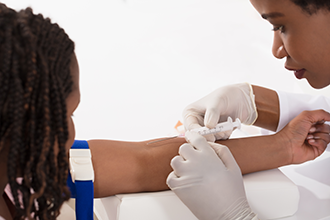The A1C Test & Race/Ethnicity
On this page:
- What is the A1C test?
- How can my racial/ethnic background affect the results of my A1C test?
- What are some common hemoglobin variants?
- How will I know if I have a hemoglobin variant?
- How can hemoglobin variants affect the A1C test and my diabetes care?
- How can I know if my diabetes is well controlled if I have a hemoglobin variant?
What is the A1C test?
The A1C test is a blood test that provides information about your average levels of blood glucose, also called blood sugar, over the past 3 months. The test is also called hemoglobin A1C, HbA1C, and glycated hemoglobin, and it is the blood glucose test that doctors most often use for managing diabetes.1
How the test works
The A1C test measures the amount of glucose in your blood that has become attached to hemoglobin. Hemoglobin is a protein that allows red blood cells to carry oxygen from your lungs to the rest of your body. When glucose enters your blood, it binds with the hemoglobin in your red blood cells. The more glucose in your blood, and the longer it stays elevated, the more it will attach to the hemoglobin.
The A1C test result is reported as a percentage. The higher the percentage, the higher your blood glucose levels. A normal A1C level is below 5.7 percent.

How can my racial/ethnic background affect the results of my A1C test?
The form of hemoglobin in your blood depends on genes you inherit from your parents. Many different forms of hemoglobin exist. The most common form is hemoglobin A, also called normal adult hemoglobin. Other, less common forms of hemoglobin are called hemoglobin variants.
Hemoglobin variants can affect the results of some A1C tests. These variants are more common in some parts of the world, such as Africa, South and Southeast Asia, and the Mediterranean. If your ancestors came from these regions, you may have a form of hemoglobin in your blood that could affect your A1C test results.

What are some common hemoglobin variants?
The most common hemoglobin variants that can affect A1C test results are hemoglobin S, C, D, and E.2 These variants can also cause hemoglobinopathies, a group of blood disorders and diseases that affect red blood cells.
Table 1 lists each variant, the racial and ethnic groups most likely to have the variant, and the blood disorders the variant can cause. In most cases, you will only develop these health problems if you inherit genes for hemoglobin variants from both of your parents. If you inherit only one hemoglobin variant, along with normal hemoglobin, you usually won’t develop any symptoms or health problems.
Table 1. Common hemoglobin variants that can affect A1C test results
| Hemoglobin Variant | Groups Most Often Affected | Related Blood Disorder |
| Hemoglobin S (HbS) |
|
Sickle cell disease
|
| Hemoglobin C (HbC) |
|
Hemoglobin C disease
|
| Hemoglobin E (HbE) |
|
Hemoglobin E disease
|
Other, less common, forms of hemoglobin that can also affect the results of the A1C test include
- Hemoglobin D. This variant, which often causes no symptoms, is not as common in the United States but has been found in people who live in China, India, Turkey, Brazil, and some parts of Europe.8
- Hemoglobin F. Also known as fetal hemoglobin, this is the main type of hemoglobin in an unborn baby’s body but is replaced with hemoglobin A after birth. Most adults have only tiny amounts of hemoglobin F in their blood, but some people may have higher levels. In some cases, health problems such as leukemia, anemia, or other blood disorders may cause adults to develop higher levels of hemoglobin F than normal.2
How will I know if I have a hemoglobin variant?
A blood test can detect hemoglobin variants. Labs may use a number of different methods to analyze your blood and identify the forms and amounts of hemoglobin in your red blood cells.
Since 2006, all states have routinely screened newborns for hemoglobin S, which causes sickle cell disease.9 Some states also screen newborns for other hemoglobin disorders, such as hemoglobin C disease and hemoglobin E disease.
If you were born before 2006, you may not know if you have one of these hemoglobin variants. Your doctor may suspect you have a hemoglobin variant if any of these are true
- your A1C test result doesn’t match the results of a prior A1C test or other types of diabetes tests, such as tests that measure blood glucose directly
- your family comes from regions of the world where hemoglobin variants are common
- you have a family history of blood disorders
Your doctor may order one or more blood tests to detect hemoglobin variants and/or signs of related blood disorders, such as anemia.
How can hemoglobin variants affect the A1C test and my diabetes care?
Having a hemoglobin variant doesn’t increase your risk for diabetes, but it can affect the results of your A1C test. Health care professionals often use A1C test results to guide decisions about your diabetes care, such as changes to your diabetes medicine, meal plan, or physical activity routine that will keep your diabetes under control.
If the A1C test gives you a false result, your doctor may think your blood glucose is higher than or lower than it really is.
- If your A1C test result is falsely high, your doctor may think that your diabetes isn’t well controlled. If you currently take medicines for diabetes, your doctor may increase the dose or make other changes to your treatment. These changes could cause low blood glucose, called hypoglycemia, or other side effects.
- If your A1C test result is falsely low, your doctor may think your diabetes is well controlled even though it isn’t. As a result, your doctor may make changes in your treatment that could cause your blood glucose to stay high. High blood glucose levels, called hyperglycemia, can increase your risk for developing problems related to diabetes in your eyes, nerves, and kidneys.

How can I know if my diabetes is well controlled if I have a hemoglobin variant?
Use an A1C test that is not affected by your hemoglobin variant. Labs can use different methods to conduct the A1C test. Not all of these methods are affected by hemoglobin variants. The NGSP, formerly called the National Glycohemoglobin Standardization Program, provides information for health care professionals on which A1C tests are appropriate to use for specific hemoglobin variants. Your doctor can arrange for your A1C test to be done at a lab that will give you accurate results.
Other options for monitoring your blood glucose levels include
- Other blood glucose tests. Your doctor can order other types of diabetes tests to monitor your blood glucose levels, such as a random or fasting plasma glucose test. But unlike the A1C test, these blood tests only provide information about your blood glucose level at one point in time.
- Self-monitoring of blood glucose. This is a blood test that you can do yourself at home by pricking your finger with a small needle, applying a drop of blood onto a test strip, and placing the strip into a blood glucose meter. People with diabetes who take oral medicines or injections, such as insulin, often use this test to monitor changes in their blood glucose.10
- Alternative tests for people with hemoglobin variants. Scientists are working on other tests to measure blood glucose in people with hemoglobin variants and related blood disorders. An example is the fructosamine test, which shows average glucose levels over about 3 weeks.11 Your doctor may want to consider if these tests are an option for you.
References
This content is provided as a service of the National Institute of Diabetes and Digestive and Kidney Diseases
(NIDDK), part of the National Institutes of Health. NIDDK translates and disseminates research findings to increase knowledge and understanding about health and disease among patients, health professionals, and the public. Content produced by NIDDK is carefully reviewed by NIDDK scientists and other experts.
The NIDDK would like to thank:
Randie R. Little, Ph.D., National Glycohemoglobin Standardization Program, University of Missouri School of Medicine

